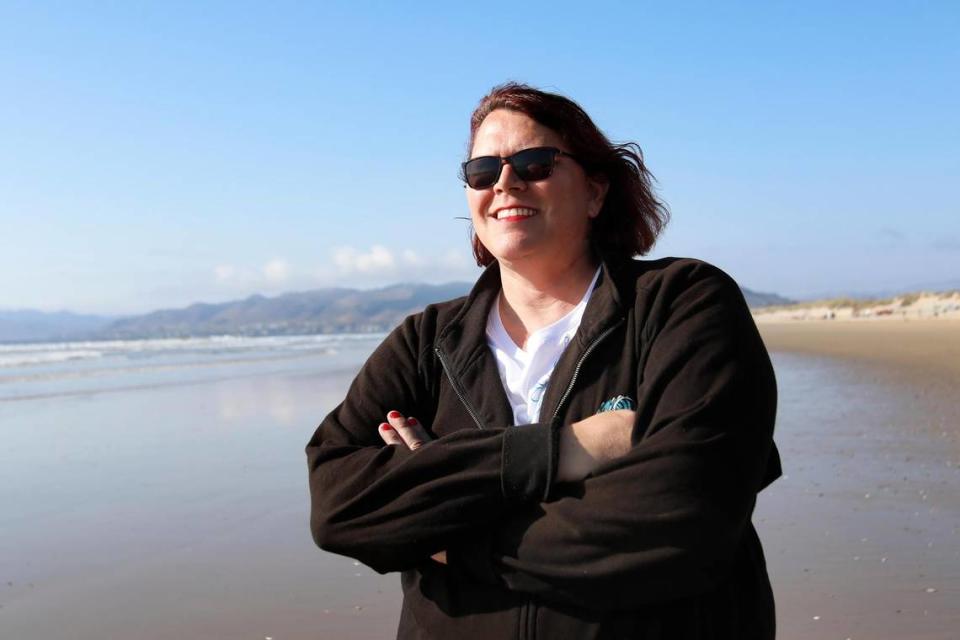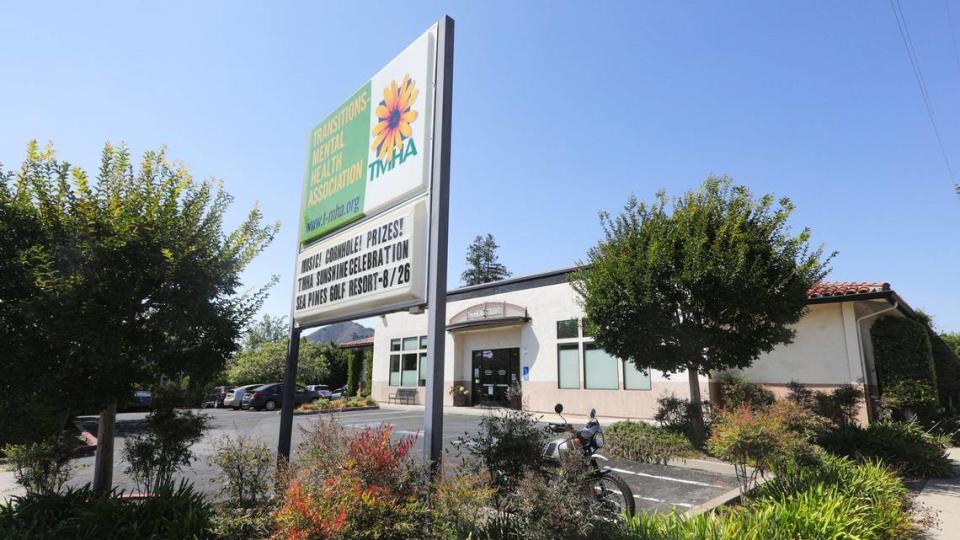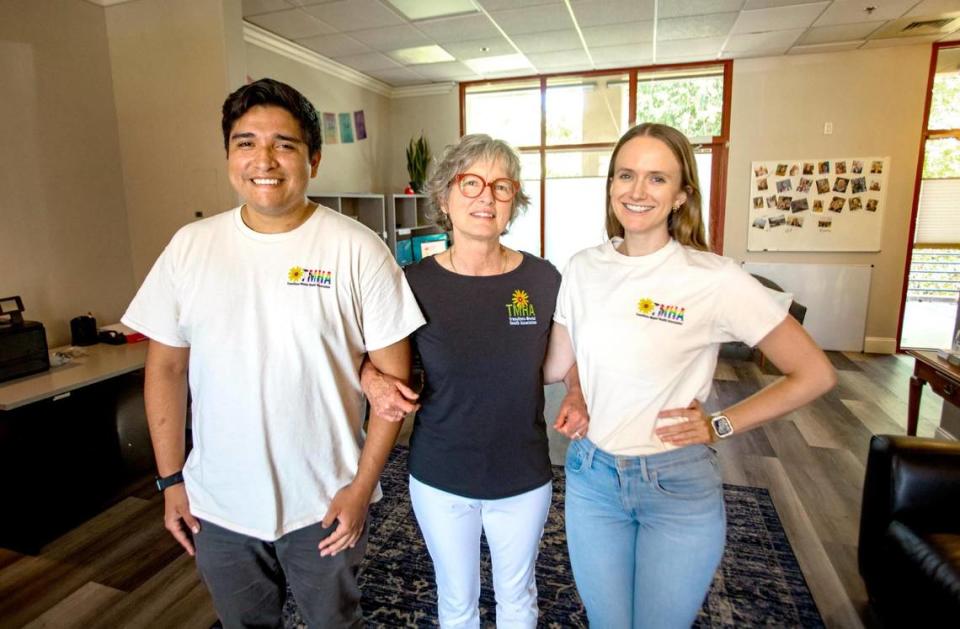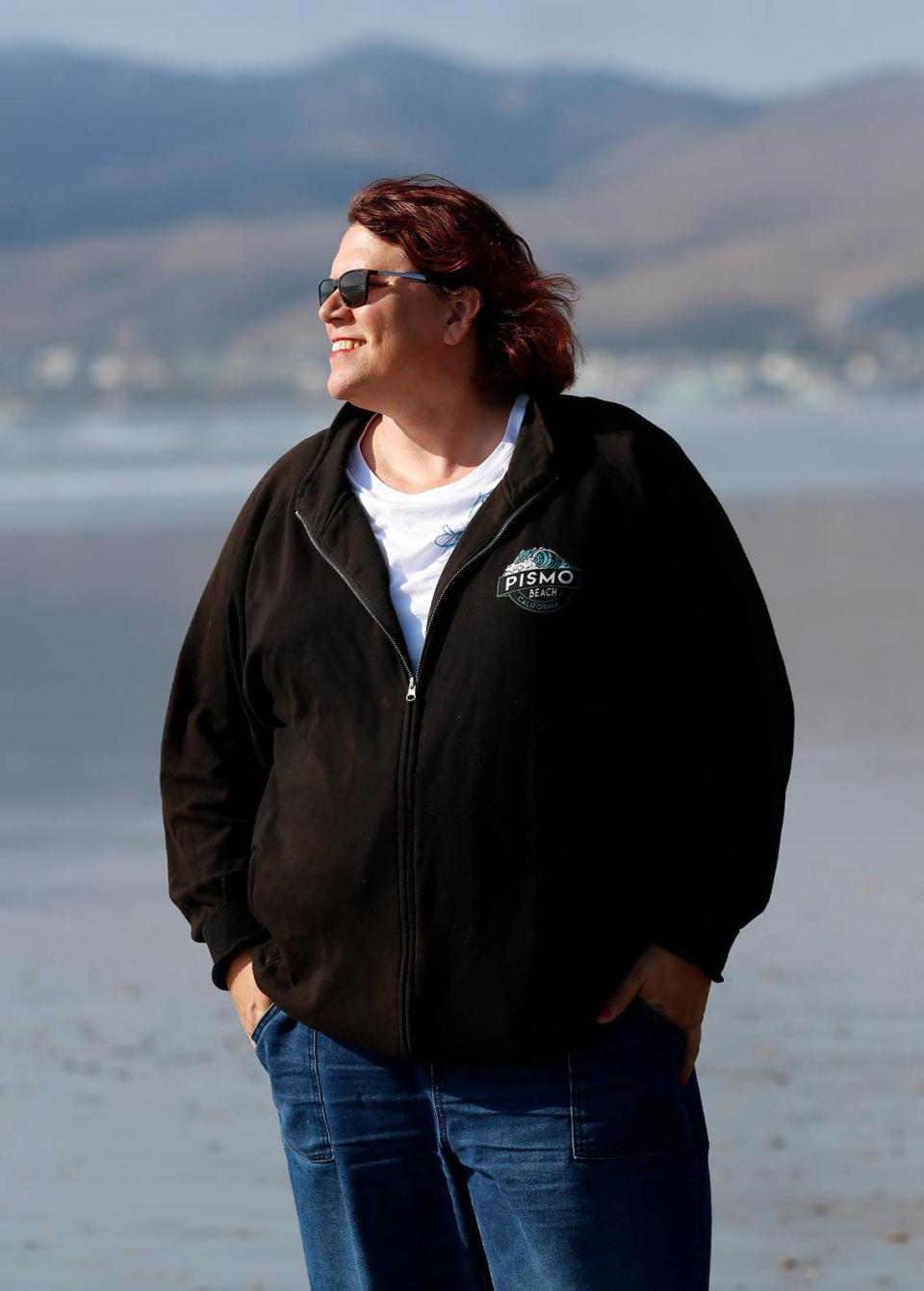‘I was just trapped.’ How SLO County veteran experiencing suicidal thoughts found help
Editor’s note: This story discusses suicide. Call or text the Central Coast Hotline at 800-783-0607 if you are thinking of hurting yourself for 24-7 assistance.
Stephanie, a retired Grover Beach resident and U.S. Army veteran, first experienced suicidal thoughts while serving in the military.
“I was going through a lot of stress with the military and with my gender identity,” said Stephanie, who asked to be identified by their first name only to protect their privacy. “I wanted to talk to the therapist about it, but I couldn’t.”
After years of struggle with depression and suicidal thoughts, Stephanie was able to find peace eight years ago after coming out as transgender to a therapist.
Today Stephanie is an active participant in a suicide attempt survivors group at Transitions-Mental Health Association in San Luis Obispo. They also lead a meditation class at T-MHA.
September is National Suicide Prevention Month, when local mental health experts share resources to help people who may be experiencing thoughts of suicide or have attempted suicide in the past get necessary support.
One of the best ways to help someone who may be experiencing thoughts of suicide is to create a safe and supportive space to talk about the challenges that may be contributing to these thoughts, T-MHA clinical director Meghan Boaz Alvarez said.
“That’s really one of the most effective things we can do for somebody who’s at risk of suicide, is provide the space for them to talk about why they’re feeling this way, have the opportunity to unburden themselves,” Boaz Alvarez said. “It may be that they have not had a safe place to do that, and that piece alone can be really significant in reducing risk and providing some hope.”
Transgender service member struggled with identity, mental health
Stephanie served in the Army for 10 years before being honorably discharged in 2005 after sustaining a service-related injury.
Stephanie, who identifies as transgender, served in the Army while U.S. military’s discriminatory Don’t Ask, Don’t Tell policy was in effect. The policy kept many gay, lesbian, bisexual, transgender and gender nonconforming service members closeted for fear of retribution.
The policy put Stephanie in an impossible situation. They wanted to serve, but were struggling with their mental health and couldn’t access mental health services or come out as transgender without risking dramatic consequences.
“It was a huge internal struggle and it made me suicidal,” Stephanie said.
In 2015, 10 years after leaving the military and four years after Don’t Ask, Don’t Tell was repealed by former President Barack Obama, Stephanie came out as transgender while in therapy at the Modesto Veterans Affairs outpatient clinic.
“I felt more pent-up emotion like I was just trapped. I couldn’t be who I wanted to be,” they said. “Being able to express that to that therapist really got a lot of that off my chest and I was able to feel more free at that point.” ’
One of the best ways to help someone who may be experiencing thoughts of suicide is to create a safe and supportive space to talk, T-MHA clinical director Meghan Boaz Alvarez said.
“That’s really one of the most effective things we can do for somebody who’s at risk of suicide, is provide the space for them to talk about why they’re feeling this way, have the opportunity to unburden themselves,” Boaz Alvarez said. “It may be that they have not had a safe place to do that, and that piece alone can be really significant in reducing risk and providing some hope.”

SLO County suicide rate is higher than state average
San Luis Obispo has been recognized as one of the happiest places in the United States, but recent data shows that the rate of suicide deaths is higher in SLO County than the state of California.
Data from the California Department of Public Health shows the age-adjusted suicide rate in California from 2018-20 was 10.5%, while it was 16.2% in San Luis Obispo County for the same period.
A total of 146 deaths by suicide were recorded in SLO County in those two years.
Ranked from the county with the highest suicide rate to the lowest, SLO County came in at No. 12 of 44 California counties, according to the data.
That disparity between SLO County’s reputation for happy living and its rate of suicide deaths is “kind of hard to wrap our heads around,” Boaz-Alvarez said.
The San Luis Obispo County Sheriff-Coroner’s Office investigates deaths that are sudden or unexpected and deaths involving suspected injury, intoxication or trauma, such as possible suicides.
Coroner’s Office data from 2019-21 shows the total number of deaths by suicide have varied.
In 2019, 49 deaths investigated by the Coroner’s Office were found to be suicide, in 2020, the number dropped to 44 and in 2021 the number of suicides jumped to 58.
As of September 2023, coroner data for 2022 deaths is still being analyzed, Sheriff’s Office Sgt. John McDaniel said in an email.
The San Luis Obispo Suicide Prevention Council, which Boaz Alvarez and many other T-MHA staffers are a part of, is working to build a stronger relationship with the Coroner’s Office in the hopes of having quicker access to data showing who is dying by suicide locally, she said.

Who is most at-risk for dying by suicide in California and SLO County?
The demographic that historically had the most deaths by suicide in California are middle-aged, white males, according to a study of population-level data on suicide deaths from 2017-21.
This is largely due to that demographic’s access to firearms, said Melanie Barket, program director of Central Coast Hotline. The mental health crisis phone number serves San Luis Obispo and Santa Barbara counties.
The study showed a change in suicide demographics in California before and after the COVID-19 pandemic. Mirroring national trends, the rate of deaths by suicide in California declined in the two years during and after the pandemic.
This was driven largely by the decline in suicide deaths among white, middle-aged men in 2020 and 2021, the study showed.
While deaths by suicide declined in this demographic, deaths by suicide increased or only decreased marginally among those that were once least likely to die by suicide: youth, women, Black, Hispanic and Asian populations in California.
Although white, middle-aged men are still more likely to die by suicide than any other group in San Luis Obispo County, there are disparities in who is more likely to attempt suicide.
Veterans and people who identify as LGBTQ+ are at a higher risk of attempting suicide than the general population, according to the federal Centers for Disease Control and Prevention.
In 2020, suicide was the second leading cause of death in U.S. military veterans under 45 and the thirteenth leading cause of death among veterans overall, according to a 2022 report by the the U.S. Department of Veterans Affairs.
Transgender veterans are twice as likely to die by suicide than cisgender veterans, according to recent VA research.
Stephanie was serving in the Army when the Sept. 11, 2023, terrorist attacks happened, followed shortly after by the wars in Iraq and Afghanistan.
“I was worried about being sent over and I had buddies that were over there and I lost some friends over there,” they said.
The stress of military life coupled with attitudes toward LGBTQ+ service members contributed to Stephanie’s depression and thoughts of suicide, they said.
“I think if the military had been like it is now, had it been accepting of LGBTQ+ people, that could have been much more helpful,” Stephanie said, because “now you can openly serve but back then you could not.”
Suicide Prevention Council reaches out to local youth
Youth experienced a spike in mental health crises during the fallout of the COVID-19 pandemic, Boaz Alvarez said, and data shows SLO County’s LGBTQ+ youth were particularly vulnerable to suicidal thoughts and attempts.
The results of the 2019-21 California Healthy Kids Survey showed that seventh, ninth and 11th graders in SLO County that identify as LGBTQ+ or are unsure of their sexuality were more likely to have considered suicide in the past 12 months compared to their heterosexual peers.
“The 10- to 14-year-olds are the fastest growing group that are considering suicide and that is tragic,” Barket said. “It’s just tragic, and we had that young of people texting us and calling us (at the Central Coast Hotline), so that’s a trend for sure.”
T-MHA has been going into local high schools to provide mental health outreach and education, Boaz Alvarez said.
Staffers go into health classrooms to talk about the importance of self-care, resiliency and mental wellness, she said.
“The messaging really works to destigmatize mental health,” Boaz Alvarez said. “Instead of waiting for someone to call the hotline or come into a community-based mental health clinic, taking that messaging out into the community and into the classroom onto our campuses is I think one of the biggest things we’re doing to reach youth.”

Central Coast Hotline answers crisis calls, texts
Since 1970, the Central Coast Hotline in San Luis Obispo has been taking calls from people in crisis. In the winter of 2022, the hotline expanded its capabilities to include text messages in an effort to reach teens.
The Central Coast Hotline responds to about 10,000 crisis calls and texts each year from people in San Luis Obispo and Santa Barbara counties, Boaz Alvarez said.
“We are the No. 1 source for suicide crises,” Barket said. “We have all the resources. We’re experts at our local resources, so we know exactly where to send people when they are in crisis.”
Unlike the people who respond to calls to the National Suicide Hotline, Central Coast Hotline specialists are up to date on resources available locally.
For instance, the behavioral health navigator program at T-MHA connects people in crisis with those with lived experiences to talk about their stressors and help them navigate the complex mental health system, Barket said.
“When you’re having challenges, it’s really nice to have an advocate or someone by your side to handhold you through the process,” she said.
The Central Coast Hotline is also available for people who need help connecting themselves or their loved one with local services, which can be complicated due to patient privacy laws.
“The people that love people that are in crisis are also in crisis,” Barket said.
T-MHA offers Zoom-based family support groups for families with adult children and children under 18 in crisis.
Finding local mental health resources can be a challenge when the San Luis Obispo County behavioral health system is strained.
To bridge the gap, T-MHA established the brief therapy clinic during COVID, which connects Cal Poly students training to be licensed therapists with the underserved for free therapy sessions.

SLO County veteran shares coping strategies, safety plan
Today, Stephanie participates in the T-MHA Support for Suicide Attempt Survivors Group, where they and other survivors share experiences and coping strategies in a nonjudgmental space.
“I have a pretty regimented activity list that I keep up to date,” Stephanie said. “Because there are a lot of different things that I do keep me regulated.”
For Stephanie, those coping strategies include taking walks outside, exercise, meditation, connecting with friends and family and therapy through the VA.
Many suicide attempt survivors have a suicide safety plan, which includes a list of resources, coping strategies and trusted support people to reach out to in case of a crisis.
Stephanie has a suicide safety app on their phone that includes resources tailored to their specific needs, with various levels of intervention depending on the level of crisis.
“If you start to feel a little upset, well, (you think about) ‘What can I do to cope with this little emergency? Well, maybe I can go for a walk or maybe I can go for a drive.’ You look at your coping mechanisms,” they said. “Then if those don’t work, and you look at ‘Who can I reach out to?’ if that doesn’t work, then what’s the next step?’ ”
“Most people that are thinking about suicide, what they need is a good intervention, a caring person to listen, the opportunity to unburden themselves and a good plan for some followup care,” Boaz Alvarez said.
How to get help if you or a loved one is having suicidal thoughts
If you notice someone has become more withdrawn or displayed warning signs of suicide, the best practice is to ask them directly.
Asking directly helps the person in crisis feel seen and heard, and introduces the opportunity to tell their story, Barket said.
A common misconception is that people who may be displaying warning signs of suicide are highly motivated to kill themselves, when in reality, many are ambivalent, Barket said.
Suicidal ambivalence can be mitigated by having open and honest conversations with someone who is truly listening, Barket said.
“That’s what we do on the hotline. We do mostly active listening and referring to resources as needed,” she said.
According to the CDC, warning signs of suicide include extreme mood swings, increased anxiety, increased substance abuse, expressing hopelessness, being isolated and talking about being a burden or feeling trapped.
People may also make plans for suicide, look up ways to access lethal means and talk or post about wanting to die.
How to get help
If you or someone you know is having thoughts of suicide, the National Suicide Prevention Lifeline is a hotline for individuals in crisis or for those looking to help someone else. To speak with a certified listener, call 988.
You can also call or text the Central Coast Hotline at 800-783-0607 for 24-7 assistance. To learn the warning signs of suicide, visit suicidepreventionlifeline.org.
The Trevor Project has resources for LGBTQ+ youth thinking of hurting themselves. Call at 1-866-488-7386 or text “START” to 678-678 to connect with a crisis counselor.
Transitions-Mental Health Association hosts a weekly LGBTQ+ lunch in September at the Safe Haven house at 203 Bridge St. in Arroyo Grande. Call 805-540-6500 or Central Coast Hotline for more information.
The Veterans Crisis Line connects veterans and service members in crisis and their families and friends with qualified, caring U.S. Department of Veterans Affairs responders through a confidential hotline, online chat, or text. Dial 988 and Press 1 or visit veterancrisisline.net for crisis chat services and more information.

